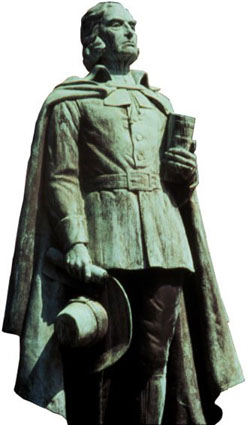The Founding of Hartford
Who founded Hartford and when?
About 100 Puritans, led by the Rev. Thomas Hooker, created a settlement on the banks of the Connecticut River in June 1636. Though this became Hartford, Hooker and his followers were not the first Europeans on the scene. Dutch traders had already built a fort at the confluence of the Connecticut and Park rivers. (For more on their fate, visit the Adriaen's Landing page of this site.) Nevertheless, Hooker not only created a lasting colony but a form of government that influenced the creation of the U.S. Constitution a century and a half later.

A statue of Thomas Hooker stands in Old State House Square, in downtown Hartford. Photo: Karen O'Maxfield.
See below for more on Hooker. Visit the Connecticut State Library site for a list of the other founders.
How did the city get its name?
It was named for Hertford, England, the birthplace of one of Hooker's assistants, the Rev. Samuel Stone.
Who lived in the area before the Europeans arrived?
The Saukiogs (Black Earth) occupied the Hartford area before Europeans arrived. The Podunks lived across the Connecticut River in what is now East Hartford, Glastonbury, and South Windsor. The Tunxis tribe lived to the west, in what is now the Farmington area.
Dutch explorers, led by Adriaen Van Block, appeared in 1614; shortly thereafter, an outbreak of measles or smallpox killed at least one-third of the Podunk population.
A Podunk chief, Wahginnacut, journeyed to Massachusetts in 1631 and invited the English colonists there to found a new settlement in the Connecticut River Valley. He wanted protection from the feared and hated Pequot tribe, which occupied what is now the southeast corner of the state. When the English arrived, they found the Hartford area ruled by Saukiog chief Sequassen, who in 1636 sold them the land that became Hartford and West Hartford. Saquassen fought fiercely with both the Pequots and the Mohegans, who also lived to the southeast. The Saukiogs "suffered severe defeats," according to Albert Van Dusen, author of "Connecticut," the preeminent history of the state. "As a result," he wrote, "the Saukiogs remained quite friendly with the colonists and lived near Hartford until about 1730."
What was so special about the government created by Hooker and the other founders?
When he lectured in his native England, Hooker drew large crowds - and unfriendly scrutiny from the state-supported Church of England. The Puritans had been hoping to reform, or "purify," the church, but at that point the church was purging itself of Puritans, so Hooker was ordered to appear before the High Commission, also known as "the star chamber." Instead, he jumped bond and fled to Holland.
From Holland, Hooker and a group of his parishioners made the trying and dangerous voyage across the Atlantic to the Massachusetts Bay Colony, settling in Cambridge, which was then known as Newtown. But they disliked the decidedly undemocratic ways of the colony's government and decided to investigate for themselves reports of fertile land in the Connecticut River Valley.
On May 31, 1638, exactly two years after he had set out from Newtown, Hooker delivered a sermon containing his vision of how the recently named Hartford should govern itself.
"The foundation of authority is laid, firstly, in the free consent of the people," he said. He went on to argue that the "choice of public magistrates belongs unto the people by God's own allowance" and that "they who have the power to appoint officers and magistrates, it is in their power also to set the bounds and limitations of the power and the place unto which they call them."
Historian Ellsworth Grant wrote, "These words were the first practical assertion ever made of the right of the governed not only to choose their rulers but to limit their powers."
The founders of Hartford, Wethersfield, and Windsor used this sermon and others from Hooker as a basis for their Fundamental Orders, considered by some to be the world's first written constitution. It's why Connecticut came to be known as the Constitution State. The Connecticut State Library's website has the text of the orders.
Sources
Web sites
- Britannica.com
- State of Connecticut:
Books
- Andrews, Gregory E., and Ransom, David F., "Structures and Styles: Guided Tours of Hartford Architecture," The Connecticut Historical Society and the Connecticut Architecture Foundation, 1988.
- Arnold, Robert H., "Hartford: Yesterday and Today," Farmcliff Press, 1985.
- Grant, Ellsworth S., "The Miracle of Connecticut," Connecticut Historical Society, 1992.
- Grant, Ellsworth Strong, and Grant, Marion Hepburn, "The City of Hartford, 1784-1984," Connecticut Historical Society, 1986.
- Van Dusen, Albert E., "Connecticut," Random House, 1961.





